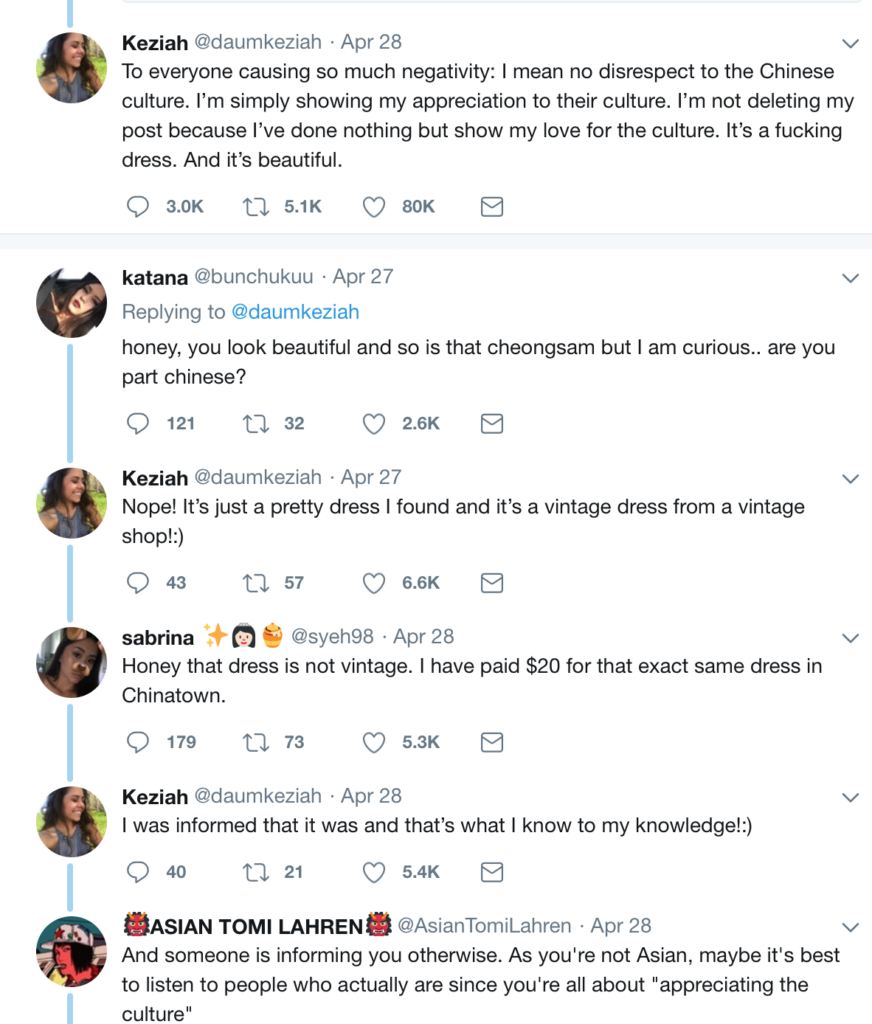The issue of cultural appropriation often comes up in the US in relation to Halloween. Costumes based on Native American traditions, for example, are considered to be inappropriate, unless one has that particular ethnic background. Especially problematic is the use of blackface by whites. This month cultural appropriation was in the news in reference to a prom dress, an important dance and social event for North American high schoolers in their last 2 years of school. An 18-year old from Utah wore a Chinese dress to the prom and posted pictures on Twitter.
This caused a great deal of tweeting about whether it was appropriate for a white American to wear this traditional Chinese dress, known as a cheongsam (from Cantonese), also known as qipao (from Mandarin Chinese):
Others on Twitter pointed out that dresses, fashions, and other items associated with particular cultures are “appropriated” all the time with no criticism:
This is in fact an issue in which opinions may vary significantly and where sensitivity is called for, as well as looking at contexts and intentionality. I wrote about that in a post last year:
In the US, assuming for fun and celebration a different ethnicity can be a tricky proposition. No one is likely to complain if a non-German wears Lederhose and a Bavarian hat to an Oktoberfest celebration. But donning a Native American costume for Halloween is considered inappropriate, an example of “cultural appropriation”. This month Is Black History month in the US, but it’s not likely any White Americans will honor African-Americans by wearing blackface. It may come down to the context in which the ethnic borrowing takes place, and the kind of portrayal used. Representing German ethnicity by wearing an SS uniform would be problematic, as would enacting an Irish identity by dressing as a starving potato farmer. It’s also the case that historically disadvantaged and mistreated groups, like American Indians and African-Americans deserve to by treated with dignity and respect by the mainstream culture, which oppressed them. There have been too many distorted and negative portrayals of those groups in the US media and culture for it too be ok to perpetuate the stereotypes.
One of the interesting aspects of both the German and the Irish events this week-end was the incorporation of women’s domestic work in a humorous or musical way. One of the talks at the Karneval Fest was given by a self-professed “Putzfrau” (cleaning lady), who brought along her mop and bucket. Two Irish sisters, preceding Cherish the Ladies (the Ganleys), did a “brush dance”, using ordinary brooms as props around which and with which they danced. Perhaps such evocations of an underprivileged class (women in domestic roles) is permissible in this instance because of the fact that both Irish-Americans and German-Americans have become part of the cultural mainstream. We White Americans can laugh at our own, confident, at least for now, in the maintenance of the power structure that provides white privilege, even for the least prestigious among us.
A related story in the news recently is about a quite different case of cultural borrowing, namely a white woman passing for black, Rachel Dolezal, who taught in the Africana Studies program at Eastern Washington University and even became head of a local chapter of the NCAAP. She has now been charged with welfare fraud, after authorities in Washington State learned that she had income from a variety of sources, while receiving public assistance from the state.



